
It was sunrise, and the Red-shouldered Hawk was in his usual tree by the boat deck at Powers Park. And he wasn't going anywhere.
Back in California, Glenn had struggled to get close-up shots of Red-shouldered Hawks. The ones we saw were always tiny rufous specks off in the distance, and skittish ones at that—if you lifted a lens in their direction 100 yards away, they'd see you and be off before you could even focus.
But not this guy. We'd seen him in that same tree, in that same spot, several weeks in a row, looking down at us disdainfully. When he wasn't in that tree, he was on the ground, only feet away. Or maybe in a nearby tree. This would have made for a perfect photo opportunity. Except for one thing.
Glenn didn't have his big lens with him, and we weren't there to take pictures. It was the Fall Migration Count, and we were there to count birds.
And thanks to our bad-ass buteo, there wasn't a songbird to be found anywhere in Powers Park. We could hear Tufted Titmice and Cardinals in the distance, and a few woodpeckers darted in and out, but no migrants were to be found. I heard a far-away Northern Parula, and a more intrepid member of our six-man/woman/child team bushwacked his way into the brush on the edge of the park and found a Kentucky Warbler, but that was it.
This had to be the lamest migration count ever. And it would only get worse.
After about three hours of hopeful but futile searching at Powers, we moved on to Gum Root Swamp, which was indeed swampy—so much so that we found ourselves stomping around in about 4 inches of brackish water for most of our time there. There, we found a couple of Yellow-billed Cuckoos, an Eastern Wood-pewee, a single American Redstart, and a Black-and-white Warbler—and, apart from a few other year-round residents, not much else. It's really sad when singles of such relatively common birds are the highlight of your count.
Then it was back to Powers Park for our lunch break. Our depressed team leaders drank beer with lunch and hoped things would improve in the afternoon. They didn't.
I've always thought that a frustrating fact about birding in Florida is that many of the bugs are as big as birds, and bird-like movements all too often turn out to be butterflies or grasshoppers. This bad photo shows how perversely large the invertebrates are out here in proportion to other critters—this spider actually has a baby gecko stuck in his web!

All at once now: Eew! Gross!
At least this was something interesting to look at. As was this Green Anole: they are native to the area, but are being pushed out by invasive Brown Anoles:

Our afternoon birding somehow managed to be even less productive than our morning attempts. But on Sunday was another day, and I spent it birding once again. A quick morning power walk through Bolen Bluff yielded a bold Ovenbird right by the trailhead, several Baltimore Orioles, a Summer Tanager, and a tree with about half a dozen Northern Parulas.
I was sure there was more to be found in there, but my time was limited: Glenn and I had reservations for Alachua Audubon's boat trip at Cedar Key. Here we enjoyed the ocean breeze and sightings of dozens of American Oystercatchers and other shorebirds:

This compensated (sort of) for Saturday's disappointment. And there will always be next weekend. And it had better not suck.







1 comment:
Howdee...
sorry about the birding...those darn hawks are wonderful to see..but they do scare off the other birds.
Nice to catch up with your blog...seems like i have been without internet for eons! But now I am going like crazy..and catching up with everyone..
I know the birds are migrating now..u should be seeing lots.
Post a Comment